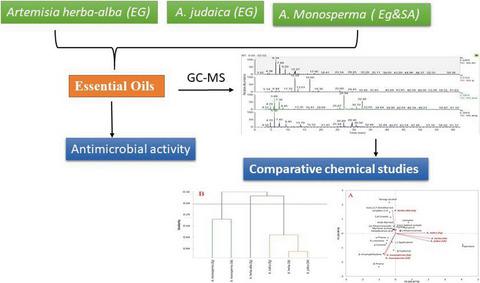当前位置:
X-MOL 学术
›
Flavour Frag. J.
›
论文详情
Our official English website, www.x-mol.net, welcomes your
feedback! (Note: you will need to create a separate account there.)
Comparative chemical study and antimicrobial activity of essential oils of three Artemisia species from Egypt and Saudi Arabia
Flavour and Fragrance Journal ( IF 2.1 ) Pub Date : 2019-08-18 , DOI: 10.1002/ffj.3525 Sahar M. Amin 1 , Hossam M. Hassan 1, 2 , Abd El‐Nasser G. El Gendy 3 , Ahmed A. El‐Beih 4 , Tarik A. Mohamed 5 , Abdelsamed I. Elshamy 6, 7 , Ammar Bader 8 , Khaled A. Shams 5 , Rabab Mohammed 2 , Mohamed‐Elamir F. Hegazy 5, 9
Flavour and Fragrance Journal ( IF 2.1 ) Pub Date : 2019-08-18 , DOI: 10.1002/ffj.3525 Sahar M. Amin 1 , Hossam M. Hassan 1, 2 , Abd El‐Nasser G. El Gendy 3 , Ahmed A. El‐Beih 4 , Tarik A. Mohamed 5 , Abdelsamed I. Elshamy 6, 7 , Ammar Bader 8 , Khaled A. Shams 5 , Rabab Mohammed 2 , Mohamed‐Elamir F. Hegazy 5, 9
Affiliation

|
The chemical composition of essential oils (EOs) distilled from three wild Artemisia species, Artemisia herba‐alba, Artemisia judaica, and Artemisia monosperma, collected from Egypt, and Saudi Arabia, were analysed by gas chromatography–mass spectrometry (GC‐MS). The antibacterial activities of the EOs for all species were determined using the Agar disc diffusion method. The yield of the EOs ranged from 0.16 to 0.49%. The results showed that A. monosperma plants growing in Saudi Arabia gave the highest yield, compared with A. herba‐alba, A. judaica, and A. monosperma collected from Egypt. In total, 92 volatile compounds were identified from the aerial parts of the plants using GC‐MS. Oxygenated monoterpenes were the major class in A. herba‐alba (75.31%) and A. judaica (83.07%), whereas monoterpene hydrocarbons were the major representative group in A. monosperma collected from both Saudi Arabia (34.23%) and Egypt (36.23%). Yomogi alcohol (22.4%), artemesia alcohol (9.91%), and 1,8‐cineole (9.68%) were the major components of the EO of A. herba‐alba, whereas camphor (31.4%), piperitone (29.9%), and endo‐borneol (5.72%) were characterized as the main compounds in A. judaica. β‐Vinylnaphthalene (24.89%), β‐eudesmol (15.41%), and β‐pinene (20.67%) represented the main components of the EO of Saudi Arabian A. monosperma, but β‐pinene (11.89%), (–)‐spathulenol (8.84%), p‐cymene (8.83%), and shyobunone (7.05%) were the major components of the EO of Egyptian A. monosperma. Herein, a comparative analysis between the EOs of Egyptian Artemisia and those collected from Saudi Arabia was performed with principal components analysis (PCA) and agglomerative hierarchical clustering (AHC). The minimum inhibitory concentration (MIC) values ranged from 0.5 to2.5 μL per disc against different microorganisms. Artemisia judaica and A. monosperma (Saudi Arabia) plants had the highest MICs and A. monosperma (Egypt) had the lowest MIC, which may indicate different compositions as a result of climatic variation.
中文翻译:

埃及和沙特阿拉伯的三种蒿属植物精油的比较化学研究和抑菌活性
从三个野生蒸馏精油(EOS)的化学组成蒿物种,蒿草-粉,蒿欧蓍草,和蒿monosperma,从埃及收集,沙特阿拉伯,通过气相色谱法-质谱法(GC-MS)进行分析。使用琼脂圆盘扩散法确定了所有物种的EOs的抗菌活性。EO的产率为0.16-0.49%。结果表明,沙特阿拉伯生长的单叶紫茎泽兰植物的产量最高,而赫尔巴-阿尔巴(A. herba -alba),朱。木(A. judaica)和单叶紫杉(A. monosperma)的产量最高。从埃及收集。使用GC-MS从植物的地上部分总共鉴定出92种挥发性化合物。含氧单萜类化合物是A. herba -alba(75.31%)和A. judaica(83.07%)的主要类别,而单萜碳氢化合物是从沙特阿拉伯(34.23%)和埃及(36.23)收集的A. monosperma的主要代表类。%)。代木酒精(22.4%),蒿木酒精(9.91%)和1,8-桉树脑(9.68%)是草曲霉(A. herba-alba) EO的主要成分,而樟脑(31.4%),哌啶酮(29.9%)和内切-borneol(5.72%)被表征为在主化合物A.欧蓍草。β-乙烯基萘(24.89%),β-艾地摩尔(15.41%)和β-pine烯(20.67%)代表沙特阿拉伯A.monosperma EO的主要成分,但β-pine烯(11.89%),(–) -spathulenol(8.84%),p -cymene(8.83%),和shyobunone(7.05%)是埃及的EO的主要组件A. monosperma。在本文中,使用主成分分析(PCA)和聚集层次聚类(AHC)对埃及蒿的EO和从沙特阿拉伯收集的EO进行了比较分析。每个圆盘对不同微生物的最小抑制浓度(MIC)值在0.5到2.5μL之间。蒿蒿和单孢曲霉(沙特阿拉伯)植物的MIC最高,而A. monosperma(埃及)的MIC最低,这可能表明气候变化导致了不同的成分。
更新日期:2019-08-18
中文翻译:

埃及和沙特阿拉伯的三种蒿属植物精油的比较化学研究和抑菌活性
从三个野生蒸馏精油(EOS)的化学组成蒿物种,蒿草-粉,蒿欧蓍草,和蒿monosperma,从埃及收集,沙特阿拉伯,通过气相色谱法-质谱法(GC-MS)进行分析。使用琼脂圆盘扩散法确定了所有物种的EOs的抗菌活性。EO的产率为0.16-0.49%。结果表明,沙特阿拉伯生长的单叶紫茎泽兰植物的产量最高,而赫尔巴-阿尔巴(A. herba -alba),朱。木(A. judaica)和单叶紫杉(A. monosperma)的产量最高。从埃及收集。使用GC-MS从植物的地上部分总共鉴定出92种挥发性化合物。含氧单萜类化合物是A. herba -alba(75.31%)和A. judaica(83.07%)的主要类别,而单萜碳氢化合物是从沙特阿拉伯(34.23%)和埃及(36.23)收集的A. monosperma的主要代表类。%)。代木酒精(22.4%),蒿木酒精(9.91%)和1,8-桉树脑(9.68%)是草曲霉(A. herba-alba) EO的主要成分,而樟脑(31.4%),哌啶酮(29.9%)和内切-borneol(5.72%)被表征为在主化合物A.欧蓍草。β-乙烯基萘(24.89%),β-艾地摩尔(15.41%)和β-pine烯(20.67%)代表沙特阿拉伯A.monosperma EO的主要成分,但β-pine烯(11.89%),(–) -spathulenol(8.84%),p -cymene(8.83%),和shyobunone(7.05%)是埃及的EO的主要组件A. monosperma。在本文中,使用主成分分析(PCA)和聚集层次聚类(AHC)对埃及蒿的EO和从沙特阿拉伯收集的EO进行了比较分析。每个圆盘对不同微生物的最小抑制浓度(MIC)值在0.5到2.5μL之间。蒿蒿和单孢曲霉(沙特阿拉伯)植物的MIC最高,而A. monosperma(埃及)的MIC最低,这可能表明气候变化导致了不同的成分。











































 京公网安备 11010802027423号
京公网安备 11010802027423号